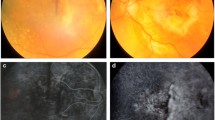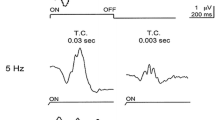Summary
Background: The recent identification of the tissue inhibitor of metalloproteinases-3 (TIMP3) as the gene underlying SFD pathology has made it possible to address the question of genetic heterogeneity in this disorder. In addition, it now has become feasible to clarify whether SFD is directly involved in other maculopathies and, in particular, may represent a genetic model for age-related macular degeneration.
Patients: Genetic analyses were performed in five unrelated and 18 related British SFD pedigrees as well as in 143 patients affected with age-related macular degeneration, 28 patients with adult vitelliform macular dystrophy, 21 patients with central areolar choroidal dystrophy and 25 individuals with other forms of macular dystrophies.
Results: Molecular genetic analyses confirmed the autosomal dominant mode of inheritance in SFD. In all five unrelated SFD pedigrees individual TIMP3 mutations were identified introducing an additional cysteine residue into the C-terminal region of the mature protein. Affected individuals from 18 SFD families residing in Great Britain, Canada, Oregon and South Africa were found to carry a common ancestral Ser181Cys mutation. The clinical variability of this Ser181Cys mutation was reevaluated. A mutational screen in 217 patients with various maculopathies revealed no disease-causing mutations in the TIMP3 gene.
Conclusion: So far, TIMP3 mutations have exclusively been associated with SFD. Therefore, this disorder appears to be genetically homogeneous with complete penetrance but variable expressivity.
Zusammenfassung
Fragestellung: Es sollen Fragen der genetischen Heterogenität bei Sorsbys Fundusdystrophie (SFD) sowie eine mögliche Modellfunktion der SFD für andere Makulopathien geklärt werden. Dies ist aufgrund der Identifizierung und Charakterisierung des verantwortlichen Gens (Gewebsinhibitor der Metalloproteinasen-3, TIMP3) auf Chromosom 22q13-qter möglich geworden.
Patienten und Methode: Molekulargenetische Mutationsanalysen wurden bei fünf nicht verwandten, sowie 18 verwandten britischen SFD-Familien, bei 143 Patienten mit altersabhängiger Makuladegeneration (AMD), bei 28 Patienten mit adulter vitelliformer Makuladystrophie (AVMD), bei 21 Patienten mit zentraler, areolärer Aderhautdystrophie (CACD) und bei 25 Individuen mit unspezifischen Makulopathien durchgeführt.
Ergebnisse: Der autosomal dominante Erbmodus der SFD wurde molekulargenetisch bestätigt. Dabei wurden 5 individuelle, pathologische TIMP3-Mutationen, die zusätzliche Zysteinreste in die C-terminale Region des TIMP3-Proteins einführen, in den untersuchten SFD-Stammbäumen nachgewiesen. Betroffene Individuen von insgesamt 18 SFD-Familien aus Großbritannien, Kanada, Oregon und Südafrika sind Träger einer identischen Ser181Cys-Mutation, die aufgrund der Resultate einer genetischen Haplotypanalyse auf einen gemeinsamen Ursprung zurückgehen sollte. Die phänotypische Variabilität der Ser181Cys-Mutation wurde daraufhin neu bewertet. Schließlich ergab ein Mutationsscreening bei 217 Patienten mit verschiedenen Makulopathien keine weiteren Mutationen im TIMP3-Gen.
Schlußfolgerung: TIMP3-Mutationen wurden bislang eindeutig und ausschließlich mit Sorsbys Fundusdystrophie assoziiert. Daher stellt diese Erkrankung eine genetisch homogene, autosomal dominante Form der Makuladegeneration dar, die eine vollständige Penetranz, jedoch variable Expressivität aufweist.
Similar content being viewed by others
Author information
Authors and Affiliations
Rights and permissions
About this article
Cite this article
Felbor, U., Weber, B. Sorsby's fundus dystrophy: a genetically homogeneous condition. Ophthalmologe 95, 287–290 (1998). https://doi.org/10.1007/s003470050274
Published:
Issue Date:
DOI: https://doi.org/10.1007/s003470050274




